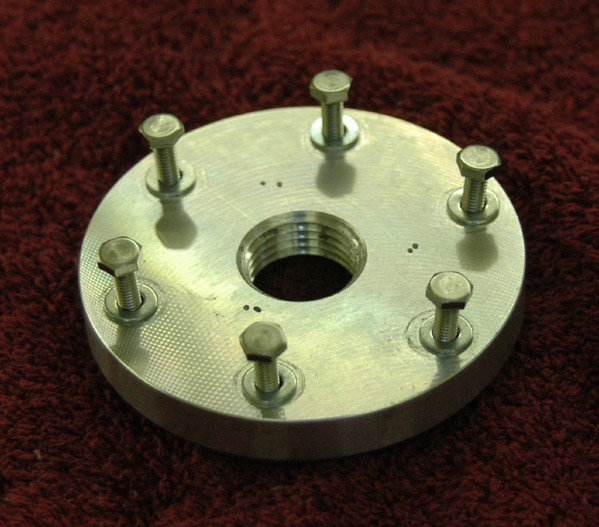My fuel gage either reads completely full or empty (with fuel light on) when I switch the sending unit wires. I'm thinking my sending unit float arm is stuck against the interior of the tank. The two wire terminals at the top of the tank are pointing to 9 o'clock. The float swing arm should be pointed to the rear of the tank. Without removing the sending unit to check the arm, is there a relationship of the arm's position and the two exterior wire leads. Any other comments?
My fuel gage either reads completely full or empty (with fuel light on) when I switch the sending unit wires. I'm thinking my sending unit float arm is stuck against the interior of the tank. The two wire terminals at the top of the tank are pointing to 9 o'clock. The float swing arm should be pointed to the rear of the tank. Without removing the sending unit to check the arm, is there a relationship of the arm's position and the two exterior wire leads. Any other comments?
Replies sorted oldest to newest

I used the Reaceready capacitance sender. You can adjust the length and it has no moving parts:
http://www.racereadyproducts.c...d-fuel-level-sender/
quote:Originally posted by comp2:
Good point. Not likely. If the overall diameter is not too big an adapter would not be hard to make.
I've seen this sending unit installed on a Pantera and always wondered where it was sourced. It's got the correct ohm rating to match the factory and my aftermarket VDO gauge. I've had trouble with installing the factory replacement sending unit. The vendors get it through the same source and none are calibrated so you have to try to bend tha float arm yourself. I gave up after the last one I changed would show empty after the fuel level fell below half tank after several attempts to calibrate it. On my last trip, I just checked my odometer and made a mental note to fill up every 200 miles.
When I bring my car back from Vegas, this will be one of my first projects. Using Centroid's Fuel Level Sender should be the final solution in getting an accurate fuel level reading. Too bad it doesn't have a built in fuel pickup though.
Edit: Found the pic of one mount on a stock pantera gas tank using an adapter.
Attachments
quote:Originally posted by LIV1S:
....I gave up after the last one I changed would show empty after the fuel level fell below half tank after several attempts to calibrate it. On my last trip, I just checked my odometer and made a mental note to fill up every 200 miles.
When I bring my car back from Vegas, this will be one of my first projects. Using Centroid's Fuel Level Sender should be the final solution in getting an accurate fuel level reading. Too bad it doesn't have a built in fuel pickup though.
Try this unit. I have just ordered one, so I don't have a review yet. It will translate any input into any output. Gotta love modern microprocessors!
http://www.technoversions.com/MeterMatchHome.html
Bringing this post back from the dead.... ;-)
Has anyone got direct experience with the Centroid fuel level sender in their Pantera?
Or any other 'floatless' sending unit?
I'm looking for an alternative to the OEM sender...
Mike
Mike,
Pantera Performance in Colorado sells a Centroid adapter for the Pantera's fuel tank. Unfortunately, there's no provision for a fuel pick-up, so you need to draw fuel from somewhere else. Accordingly, I replaced the drain plug on the bottom of the tank with a high flow banjo fitting from BAT in Florida. I suppose an adapter could be machined that incorporates a fuel pick-up but I decided to go with the PPC adapter.
Centroid has had a few Pantera owners and vendors provide them with calibration data. Centroid warned me that the specs they have been provided with differed quite a bit, so they were the most comfortable if I provided my own calibration specs.
The other thing they warned me about was, due to the design of the Pantera's fuel level gauge, it is sensitive to input voltage. It will read differently with the engine "off" and the engine "running". They said the Veglia gauge works fine with +6V, so their advice was to supply power with a +6V voltage regulator. That way, it always reads the same, as long as the car's battery/alternator voltage is higher than +6 volts. The sending unit then needs to be calibrated for +6V, for the gauge to read accurately.
Attachments
Hi David,
My electric fuel pump picks up fuel from the bottom of the tank already, so no worries there. However, the return line after my regulator utilizes the old pick-up location, so I'd have to find a spot for that...
I like the idea of the capacitive sending unit, no moving parts to wear out.
There are a few other options I'm considering:
https://www.tanksinc.com/index...mode=prod/prd346.htm
https://www.vdo-gauges.com/sen...50mm-240-33-ohm.html
https://shop.classicinstruments.com/sn35t
All three of the above are 'two-wire' solutions, so they're simply some sort of variable resistance to ground.
Mike




